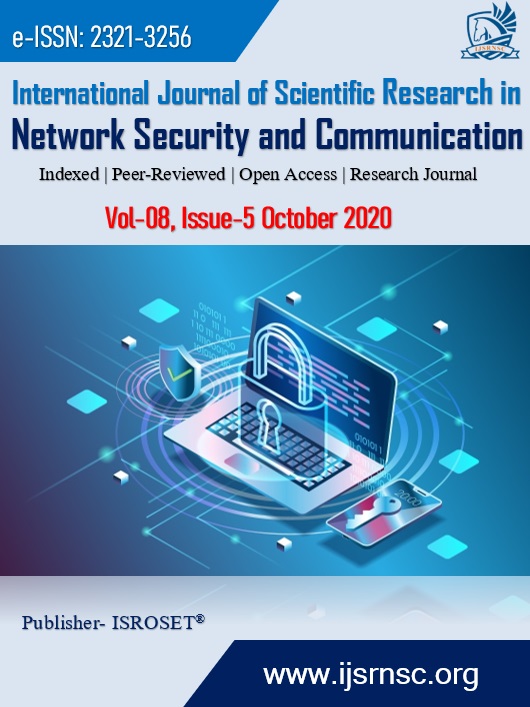Study on IoT Architecture, Application Protocol and Energy needs
Keywords:
IoT Architecture, MQTT, XMPP, CoAP, AMQP, DDS, EnergyAbstract
In this digital world Internet of Things plays major role in different fields. These IoT devices are extended from Wireless Sensor Network (WSN). This paper we discussed three areas of IoT the architecture, protocols and their energy requirements. Because energy is very most emerging part of IoT devices. Architecture of IoT is very complex one it provides most of the services over the Internet. As far as the application protocols have vital role in end-user level. The IoT device energy efficiency of the nodes is a key factor in the network performance and increasing the life time. In this paper, we discuss the architecture and protocols energy importance for IoT. In this paper we focused IoT application layer comparative study of existing protocols and highlighted some standard IoT application protocol, importance of energy requirements in IoT and existing algorithms are what proposed in some researcher aspects for consuming the energy. This paper focus on analyze the IoT application architecture based lifetime of IoT devices energy management or consuming is future trends in most research challenges that lie ahead. Finally, we provide our conclusion about IoT application layer architecture based on the study that we have conducted.
References
A. Perera, Charith Research School of Computer Science, The Australian National University, Canberra, ACT 0200, “Sensing as a service model for smart cities supported by Internet of Things,” Trans. Emerg. Telecommun. Technol., vol. Trans. Eme, no. SPECIAL ISSUE-SMART CITIES, pp. 81–93, 2014.
K. S. Mohamed, The Era of Internet of Things. Cham: Springer International Publishing, 2019.
P. Sethi and S. R. Sarangi, “Internet of Things: Architectures, Protocols, and Applications,” J. Electr. Comput. Eng., vol. 2017, 2017.
B. N. Silva, M. Khan, and K. Han, “Internet of Things: A Comprehensive Review of Enabling Technologies, Architecture, and Challenges,” IETE Tech. Rev., vol. 0, no. 0, pp. 1–16, 2017.
M. Burhan, R. A. Rehman, B. Khan, and B. S. Kim, “IoT elements, layered architectures and security issues: A comprehensive survey,” Sensors (Switzerland), vol. 18, no. 9, pp. 1–37, 2018.
M. Yun and B. Yuxin, “Research on the architecture and key technology of Internet of Things (IoT) applied on smart grid,” 2010 Int. Conf. Adv. Energy Eng. ICAEE 2010, pp. 69–72, 2010.
H. A. Khattak, M. A. Shah, S. Khan, I. Ali, and M. Imran, “Perception layer security in Internet of Things,” Futur. Gener. Comput. Syst., vol. 100, pp. 144–164, 2019.
D. G. Darwish and E. Square, “Improved Layered Architecture for Internet of Things,” Int. J. Comput. Acad. Res., vol. 4, no. 4, pp. 214–223, 2015.
S. Narayanaswamy and A. V. Kumar, “Application layer security authentication protocols for the internet of things: A survey,” Adv. Sci. Technol. Eng. Syst., vol. 4, no. 1, pp. 317–328, 2019.
J. M. Shivangi Vashi,Jyotsnamayee Ram, “Internet of Things (IoT) A Vision, Architectural Elements, and Security Issues,” Int. Conf. I-SMAC (IoT Soc. Mobile, Anal. Cloud) (I-SMAC 2017)978-1-5090-3243-3/172017 IEEE, pp. 492–496, 2017.
D. Priyadarshi and A. Behura, “Analysis of Different IoT Protocols for Heterogeneous Devices and Cloud Platform,” in 2018 International Conference on Communication and Signal Processing (ICCSP), pp. 0868–0872, 2018.
B. H. Corak, F. Y. Okay, M. Guzel, S. Murt, and S. Ozdemir, “Comparative Analysis of IoT Communication Protocols,” in 2018 International Symposium on Networks, Computers and Communications (ISNCC), pp. 1–6, 2018.
P. Datta and B. Sharma, “A Survey on IoT Architectures, Protocols, Security and Smart City based Applications.”
V. Karagiannis, P. Chatzimisios, F. Vazquez-Gallego, and J. Alonso-Zarate, “A Survey on Application Layer Protocols for the Internet of Things,” Trans. IoT Cloud Comput., vol. 3, no. 1, pp. 11–17, 2015.
J. A.-Z. Vasileios Karagiannis, Periklis Chatzimisios, Francisco Vazquez-Gallego, “A Survey on Application Layer Protocols for the Internet of Things,” Trans. IoT Cloud Comput., vol. 3, no. January 2015, pp. 11–17, 2015.
S. Bendel, T. Springer, D. Schuster, A. Schill, R. Ackermann, and M. Ameling, “A service infrastructure for the Internet of Things based on XMPP,” 2013 IEEE Int. Conf. Pervasive Comput. Commun. Work. PerCom Work. 2013, no. March, pp. 385–388, 2013.
S. F. Abedin, M. G. R. Alam, R. Haw, and C. S. Hong, “A system model for energy efficient green-IoT network,” Int. Conf. Inf. Netw., vol. 2015-Janua, pp. 177–182, 2015.
S. Park, S. Cho, and J. Lee, “Energy-Efficient Probabilistic Routing Algorithm for Internet of Things,” J. Appl. Math., vol. 2014, pp. 1–7, 2014.
R. Dhall and H. Agrawal, “An improved energy efficient duty cycling algorithm for IoT based precision agriculture,” in Procedia Computer Science, vol. 141, pp. 135–142, 2018.
Z. Ali, S. Henna, A. Akhunzada, M. Raza, and S. W. Kim, “Performance Evaluation of LoRaWAN for Green Internet of Things,” IEEE Access, vol. 7, pp. 164102–164112, 2019.
K. L. Tsai, Y. L. Huang, F. Y. Leu, I. You, Y. L. Huang, and C. H. Tsai, “AES-128 based secure low power communication for LoRaWAN IoT environments,” IEEE Access, vol. 6, pp. 45325–45334, 2018.
Downloads
Additional Files
Published
How to Cite
Issue
Section
License

This work is licensed under a Creative Commons Attribution 4.0 International License.
Authors contributing to this journal agree to publish their articles under the Creative Commons Attribution 4.0 International License, allowing third parties to share their work (copy, distribute, transmit) and to adapt it, under the condition that the authors are given credit and that in the event of reuse or distribution, the terms of this license are made clear.









